True storyThis is some truly beautiful work, Sergey! You have a rare gift!
-

Win a Free Custom Engraved Brass Coin!!!
As a way to introduce our brass coins to the community, we will raffle off a free coin during the month of August. Follow link ABOVE for instructions for entering.
-
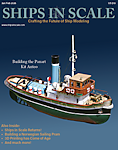
PRE-ORDER SHIPS IN SCALE TODAY!
The beloved Ships in Scale Magazine is back and charting a new course for 2026!
Discover new skills, new techniques, and new inspirations in every issue.
NOTE THAT OUR FIRST ISSUE WILL BE JAN/FEB 2026
- Home
- Forums
- Ships of Scale Group Builds and Projects
- HMS Alert 1777 1:48 PoF Group Build
- HMS Alert 1777 1:48 Group Build Logs
You are using an out of date browser. It may not display this or other websites correctly.
You should upgrade or use an alternative browser.
You should upgrade or use an alternative browser.
HMS Alert [1777] 1:48 POF by serikoff. (Two hulls: skeleton and fully rigged)
Your gratings are really fine!! Do you know if the outer ledges were ever cut half way to accept the battens as you show, or totally across, or were both methods used at times? Pictures below. Up to now I had only seen them as in the drawing on the left and the last two pictures below but what you show looks structurally sound as well.
Many thanks
Allan
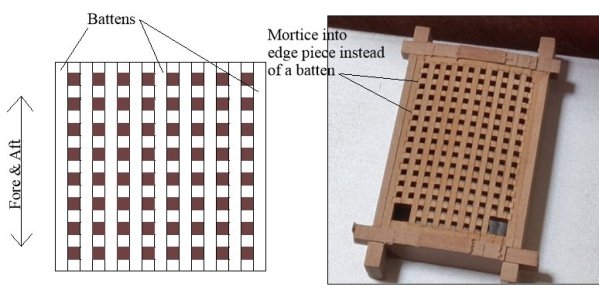
HMS Victory today
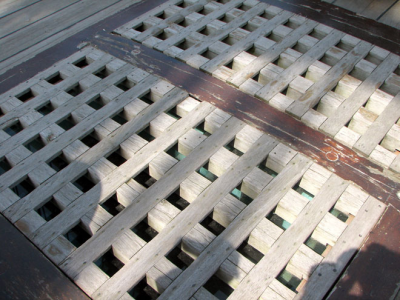
Contemporary model
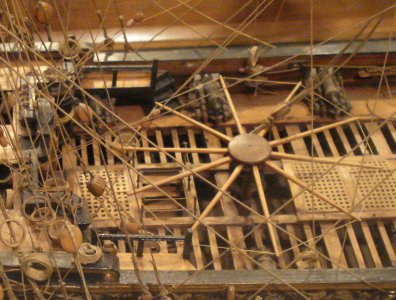
Many thanks
Allan

HMS Victory today

Contemporary model

Thank you, friend.True story
Thanks for the praise.Your gratings are really fine!! Do you know if the outer ledges were ever cut half way to accept the battens as you show, or totally across, or were both methods used at times? Pictures below. Up to now I had only seen them as in the drawing on the left and the last two pictures below but what you show looks structurally sound as well.
Many thanks
Allan
There are at least two types of gratings: a simple one (the one you showed) and a more complex one with the slats embedded in the sides.
Alert's anatomy indicates the second type.
I certainly didn't come up with anything myself, but from what I could quickly find, this is the grid from Granado's anatomy.
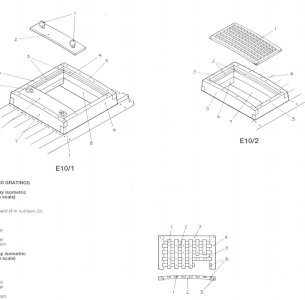
And to be honest, I'm glad that the model I'm building is built this way, and even though it's more difficult, I like it better this way.
I think the first option is more common on larger ships, and the second on smaller ones.
Main Hatchway.
3/3
The final stage is creating the frame for the first body.
First, I make grooves in the "table" attached to the machine. I insert the two side frame pieces into these grooves and glue them with drops of CA gel. Then, I mill the groove in both pieces at once with a 2mm router bit.
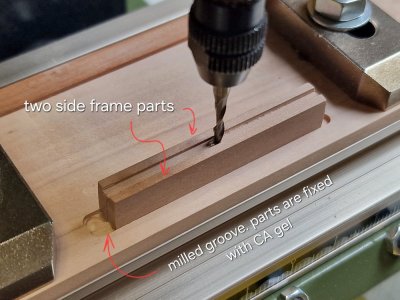
Then I mill the side pieces so that they can be joined to the other two pieces.
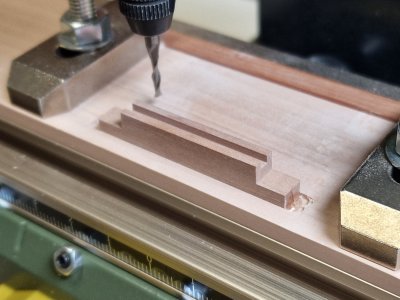
I make the same groove in the front and back of the frame.
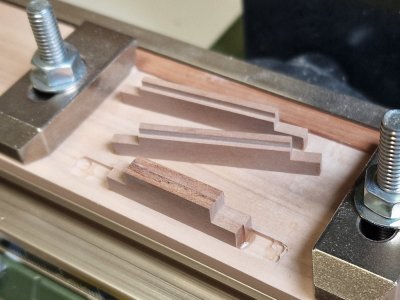
And now you can put them together and check the fit.
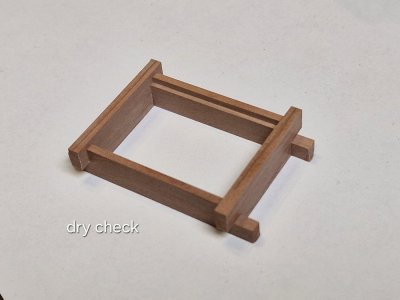
Then I profile the front and back of the frame...
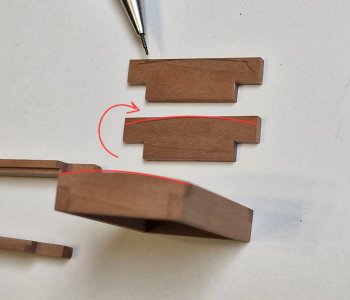
... and I glue everything together at a 90 degree angle using liquid CA.
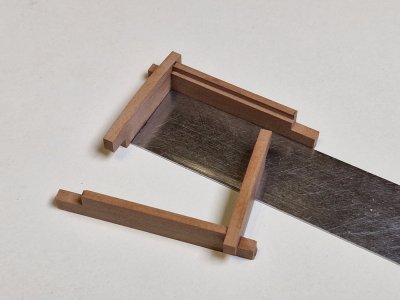
I glue the entire joint so that after sanding the glue line is visible for greater visualization.
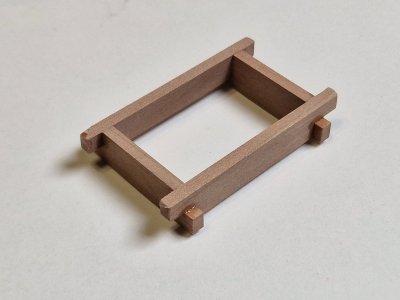
I sand the plane and the ends.
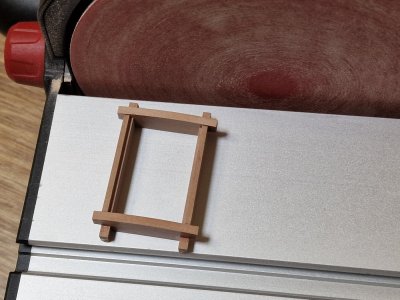
Then I sand the top surface, giving it an arc shape.
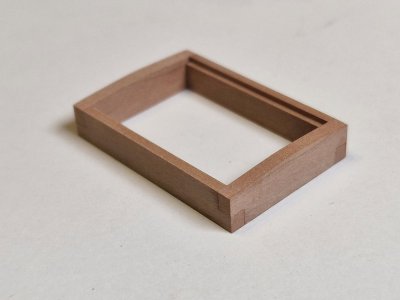
The photo above shows how the frame sections are connected. I plan to add imitation bolts at the joints in the future, just like where the bolts used to secure the frame to the beams and carlings. Finally, I've finally secured the front and rear grating stops.
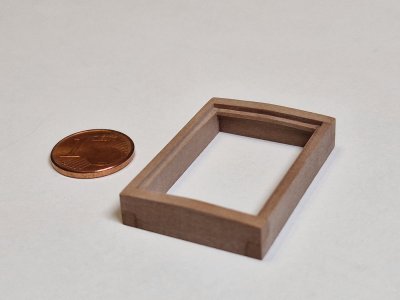
On the side parts of the frame, the grille lay on the side parts of the frame themselves, and at the front and back, the grille was held in place by stoppers.
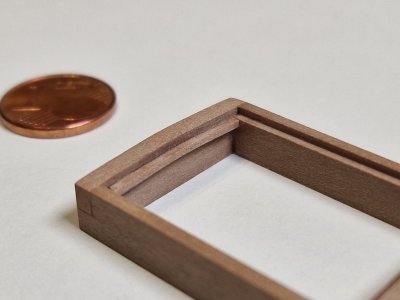
Well, here is the intermediate result (if you don’t take into account bolts and nailing).
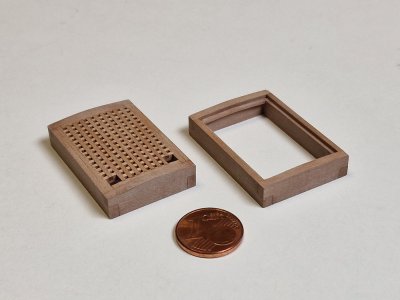
On the right is the frame for the first hull, and on the left is the frame with grating for the second hull.
A little macro:
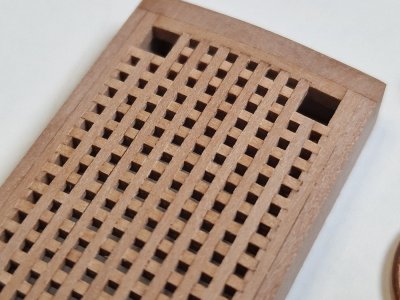
Well, this is how they will look in height on the hulls.
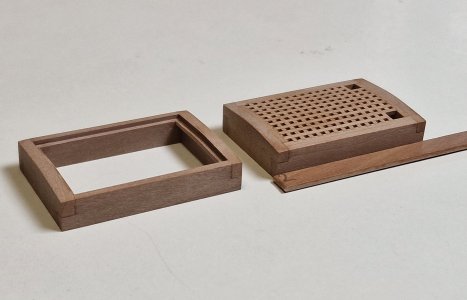
On the left, the frame stands as if on beams and carlings, and on the right, the deck board will cover part of the frame and it will be lower (visually).
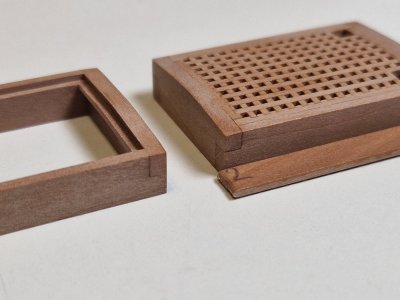
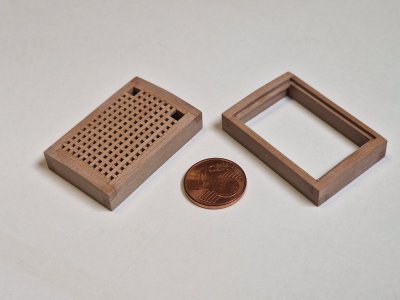
Now it's the turn of the last (front) grating, it's even more difficult there, so don't miss it.
3/3
The final stage is creating the frame for the first body.
First, I make grooves in the "table" attached to the machine. I insert the two side frame pieces into these grooves and glue them with drops of CA gel. Then, I mill the groove in both pieces at once with a 2mm router bit.

Then I mill the side pieces so that they can be joined to the other two pieces.

I make the same groove in the front and back of the frame.

And now you can put them together and check the fit.

Then I profile the front and back of the frame...

... and I glue everything together at a 90 degree angle using liquid CA.

I glue the entire joint so that after sanding the glue line is visible for greater visualization.

I sand the plane and the ends.

Then I sand the top surface, giving it an arc shape.

The photo above shows how the frame sections are connected. I plan to add imitation bolts at the joints in the future, just like where the bolts used to secure the frame to the beams and carlings. Finally, I've finally secured the front and rear grating stops.

On the side parts of the frame, the grille lay on the side parts of the frame themselves, and at the front and back, the grille was held in place by stoppers.

Well, here is the intermediate result (if you don’t take into account bolts and nailing).

On the right is the frame for the first hull, and on the left is the frame with grating for the second hull.
A little macro:

Well, this is how they will look in height on the hulls.

On the left, the frame stands as if on beams and carlings, and on the right, the deck board will cover part of the frame and it will be lower (visually).


Now it's the turn of the last (front) grating, it's even more difficult there, so don't miss it.
I am not so sure White is correct as I could not find any contemporary based information anywhere that gratings on large or small vessels had the design White shows. Even so, there were very few things where the words "always" or "never" in the ships in the days of sail applies so I would not be surprised if two designs were used.There are at least two types of gratings: a simple one (the one you showed) and a more complex one with the slats embedded in the sides.
Your head ledges and coaming assemblies are beautifully done.
Allan
From a 14 gun contemporary model circa 1795 --- RMG ID: SLR0580
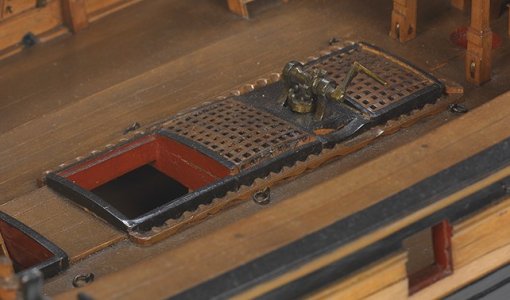
3. Fore Hatchway.
1/3
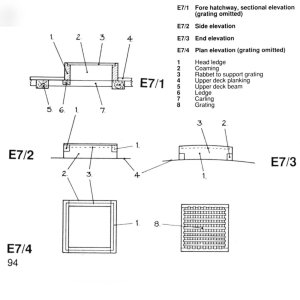
Each grating on this ship has its own unique characteristics. I was very interested in thinking through every detail to ensure I could implement them all in wood. I've mentioned this many times before, but even before I started work, I designed all the gratings in a 3D program.
In the anatomy (photo above), you can see that the grating is square, but has a different number of horizontal and vertical slats. To achieve this, I calculated that the width of the smaller slats is 1 mm, and the width of the larger slats is 0.8 mm.
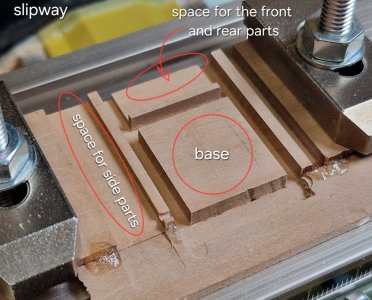
In order to mill the base and side parts of the grating at the same time, I made a jig and fixed the side parts in the prepared grooves using CA gel.
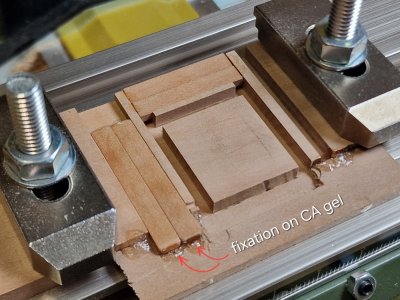
After that, I reset the height. That is, I leveled the entire surface with a face mill and set the Z-axis on the router to zero.
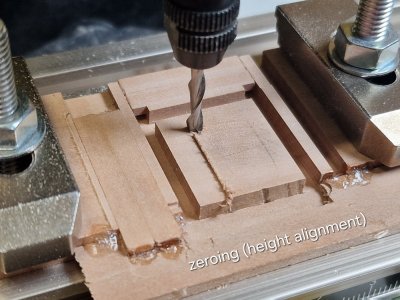
And here I made a mistake... for the first time ever. I expected it to happen sooner, as there are so many different points and places where mistakes can be made, but I only made a mistake on the third grating.
The mistake was that I needed to leave 1.5 mm on the side, but I immediately started routing with a 0.8 mm margin.
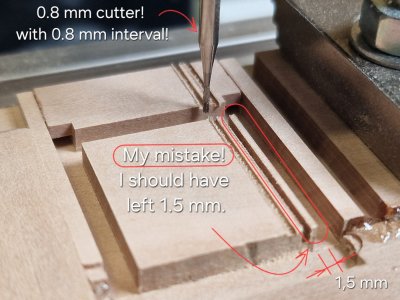
But since there was some material left on the other side, I cut out the required 1.5 mm fragment, tore it off and glued it in place of the one that I had mistakenly made smaller; before that, I had cut off this smaller fragment.

The end result was this:
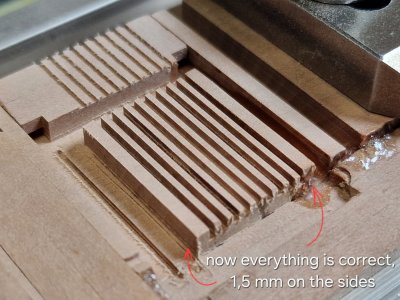
Now I changed the cutter to 1 mm and began to make grooves to the full depth with an interval of 1 mm.
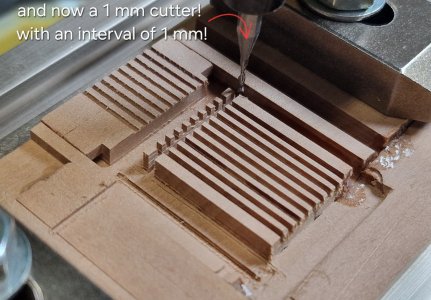
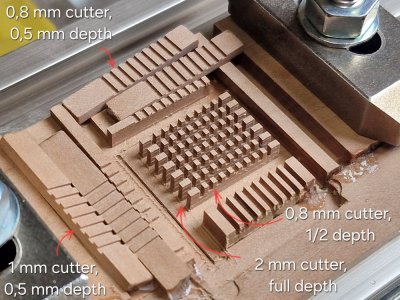
After polishing and removing the lint, I glued on 0.8mm slats and cut off 1.5mm on the sides. I glued the slats at different heights because I also made the cuts at different depths, just like last time, so I could sand them along the arc later.
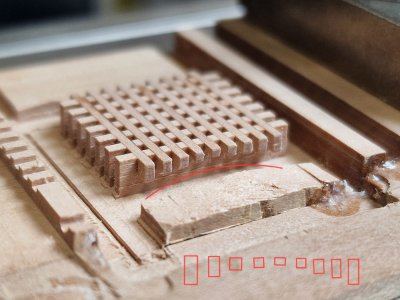
Then I glued the front and back pieces and after trimming the edges I glued the side pieces.
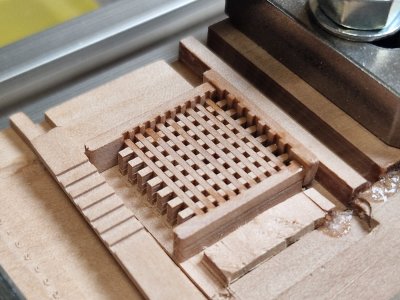
As a result, after cutting off the edges, I got this result:
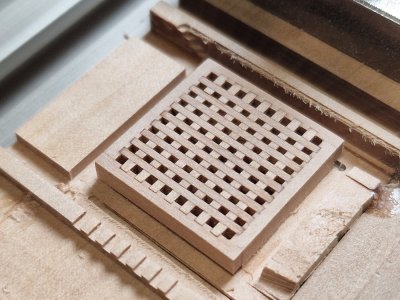
And after separation from the slipway, it looks like this:
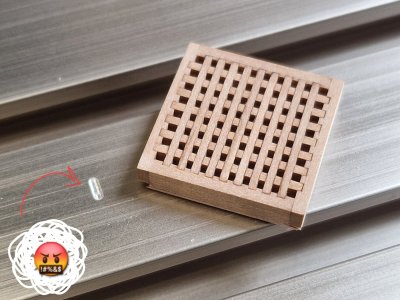
I liked the result, but something else was disappointing... I accidentally drilled all the way through the frame and hit the alignment table. (Oh, it happens.)
Finally, I cut off part of the base from the bottom of the grating, and after that, I'll be able to profile it, but that's for the next part. For now, here's what I got:
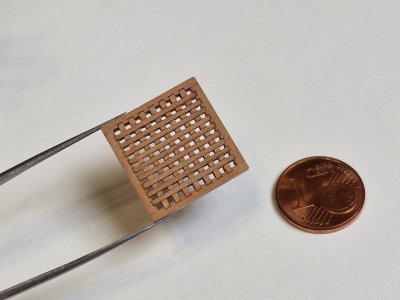
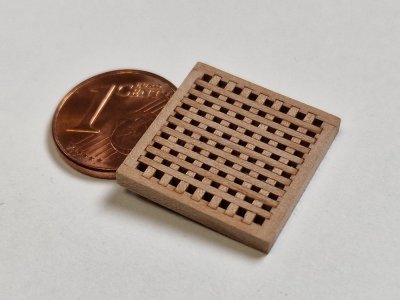
I haven't decided yet whether I'll build a single structure—a grating and frame—or a removable grating. I'm thinking of mounting the grating on the frame at an angle using supports, since the sailors used to walk through this opening (there was a ladder there). So, in theory, I'm thinking of making the hatch partially open, but I'll see if that's feasible.
1/3

Each grating on this ship has its own unique characteristics. I was very interested in thinking through every detail to ensure I could implement them all in wood. I've mentioned this many times before, but even before I started work, I designed all the gratings in a 3D program.
In the anatomy (photo above), you can see that the grating is square, but has a different number of horizontal and vertical slats. To achieve this, I calculated that the width of the smaller slats is 1 mm, and the width of the larger slats is 0.8 mm.

In order to mill the base and side parts of the grating at the same time, I made a jig and fixed the side parts in the prepared grooves using CA gel.

After that, I reset the height. That is, I leveled the entire surface with a face mill and set the Z-axis on the router to zero.

And here I made a mistake... for the first time ever. I expected it to happen sooner, as there are so many different points and places where mistakes can be made, but I only made a mistake on the third grating.
The mistake was that I needed to leave 1.5 mm on the side, but I immediately started routing with a 0.8 mm margin.

But since there was some material left on the other side, I cut out the required 1.5 mm fragment, tore it off and glued it in place of the one that I had mistakenly made smaller; before that, I had cut off this smaller fragment.

The end result was this:

Now I changed the cutter to 1 mm and began to make grooves to the full depth with an interval of 1 mm.


After polishing and removing the lint, I glued on 0.8mm slats and cut off 1.5mm on the sides. I glued the slats at different heights because I also made the cuts at different depths, just like last time, so I could sand them along the arc later.

Then I glued the front and back pieces and after trimming the edges I glued the side pieces.

As a result, after cutting off the edges, I got this result:

And after separation from the slipway, it looks like this:

I liked the result, but something else was disappointing... I accidentally drilled all the way through the frame and hit the alignment table. (Oh, it happens.)
Finally, I cut off part of the base from the bottom of the grating, and after that, I'll be able to profile it, but that's for the next part. For now, here's what I got:


I haven't decided yet whether I'll build a single structure—a grating and frame—or a removable grating. I'm thinking of mounting the grating on the frame at an angle using supports, since the sailors used to walk through this opening (there was a ladder there). So, in theory, I'm thinking of making the hatch partially open, but I'll see if that's feasible.
Last edited:



